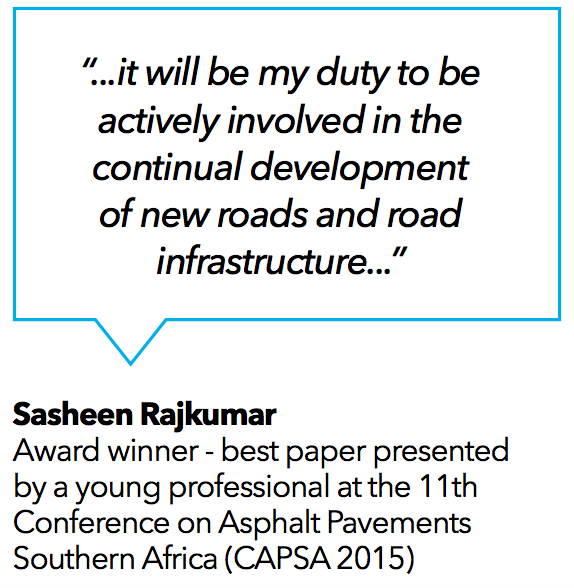Pietermaritzburg-based project engineer-in-training, Sasheen Rajkumar, is paving the road to success after winning the award for the best paper presented by a young professional at the 11th Conference on Asphalt Pavements for Southern Africa (CAPSA 2015) held at Sun City recently.
Rajkumar, 25, is employed at SANRAL’s Eastern Region and is studying for a Master of Science degree, part-time, through the University of KwaZulu-Natal (UKZN).
The CAPSA 2015 conference hosted by the Southern African Bitumen Association (Sabita) focused on, among other matters, optimising structural design in new construction and rehabilitation; the design of asphalt layers and spray seals to ensure efficient application and adequate performance; and construction, practice and materials assessment for a high level of efficiency.
Rajkumar, who always enjoyed mathematics and science at Raisethorpe Secondary School, studied civil engineering at UKZN, thanks to a SANRAL bursary, and graduated with a BSc in Engineering in 2012.
In 2013, he registered as a full-time post-graduate student for the MSc in Engineering with a bursary from SANRAL.
He approached SANRAL’s Eastern Region office and asked if there was a potential topic in pavement materials that the agency would like to be researched. The materials specialist, Dennis Rossmann pointed him towards the “green” roads that were being built by recycling the old milled asphalt pavement.
“I had spent a year at university gathering technical literature on the procedures of recycling reclaimed asphalt (RA) and compared international practice with local methods.
At the time, SANRAL had allowed up to 25% of RA to be used as a material component with new materials (new aggregate and bitumen) in hot mix asphalt.
The incorporation of RA into a new mix results in a reduction of new materials – which in turn means cost savings as well as a benefit to the environment.
I conducted lab experiments that simulated mixing at the hot mix asphalt plant using high proportions of RA mixed with new materials.
I found that with up to 40% RA, all of the RA bitumen blended with the new bitumen, whereas, at 60% RA, only some of the RA and new bitumen blended.
I compiled a technical paper of my findings and submitted this to for CAPSA 2015.”
Rajkumar said he was grateful to SANRAL for all the opportunities he had been afforded and to all those people who had imparted valuable knowledge to him.
He is currently busy completing his Master’s thesis which is going to be an extension of the CAPSA paper.




